Management Skills and Career Development in Hospitality Sector
VerifiedAdded on 2024/06/12
|24
|6054
|314
Report
AI Summary
This report elaborates on management styles and leadership characteristics applicable to organizations like Thomas Cook and Thomson, focusing on how these elements contribute to organizational growth. It assesses essential managerial qualities for achieving business objectives and goals. The report compares different management styles, including autocratic, democratic, and laissez-faire, and examines communication processes, organizational culture, and change management in selected businesses. A personal assessment of management skills, including strengths, weaknesses, opportunities, and threats, is conducted to set and prioritize objectives for personal development. The report also discusses leading and motivating teams, justifying managerial decisions, and outlining a career development plan to support future career advancements, with an emphasis on the hospitality sector.
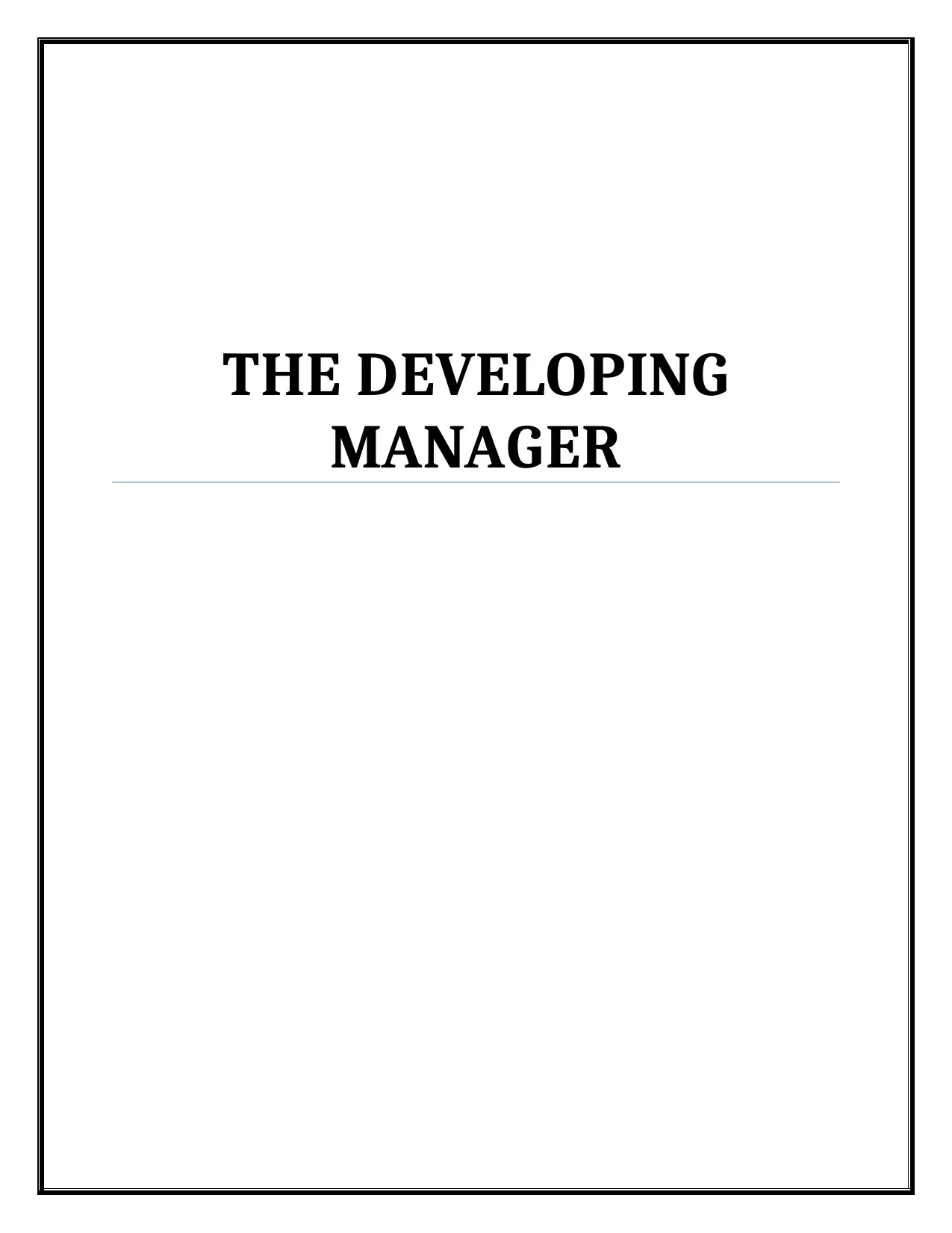
THE DEVELOPING
MANAGER
MANAGER
Paraphrase This Document
Need a fresh take? Get an instant paraphrase of this document with our AI Paraphraser
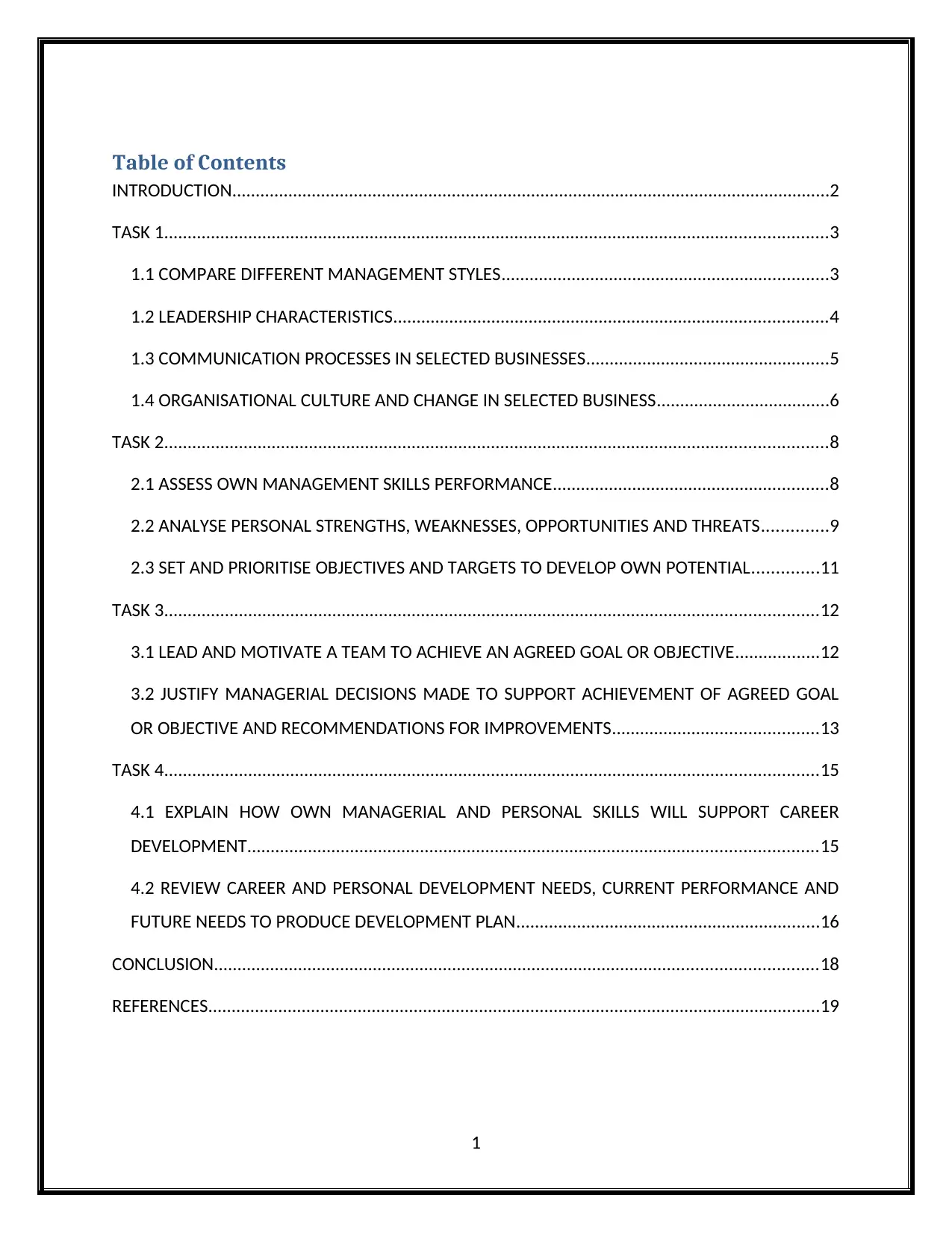
Table of Contents
INTRODUCTION................................................................................................................................2
TASK 1..............................................................................................................................................3
1.1 COMPARE DIFFERENT MANAGEMENT STYLES......................................................................3
1.2 LEADERSHIP CHARACTERISTICS.............................................................................................4
1.3 COMMUNICATION PROCESSES IN SELECTED BUSINESSES....................................................5
1.4 ORGANISATIONAL CULTURE AND CHANGE IN SELECTED BUSINESS.....................................6
TASK 2..............................................................................................................................................8
2.1 ASSESS OWN MANAGEMENT SKILLS PERFORMANCE...........................................................8
2.2 ANALYSE PERSONAL STRENGTHS, WEAKNESSES, OPPORTUNITIES AND THREATS..............9
2.3 SET AND PRIORITISE OBJECTIVES AND TARGETS TO DEVELOP OWN POTENTIAL..............11
TASK 3............................................................................................................................................12
3.1 LEAD AND MOTIVATE A TEAM TO ACHIEVE AN AGREED GOAL OR OBJECTIVE..................12
3.2 JUSTIFY MANAGERIAL DECISIONS MADE TO SUPPORT ACHIEVEMENT OF AGREED GOAL
OR OBJECTIVE AND RECOMMENDATIONS FOR IMPROVEMENTS............................................13
TASK 4............................................................................................................................................15
4.1 EXPLAIN HOW OWN MANAGERIAL AND PERSONAL SKILLS WILL SUPPORT CAREER
DEVELOPMENT..........................................................................................................................15
4.2 REVIEW CAREER AND PERSONAL DEVELOPMENT NEEDS, CURRENT PERFORMANCE AND
FUTURE NEEDS TO PRODUCE DEVELOPMENT PLAN.................................................................16
CONCLUSION.................................................................................................................................18
REFERENCES...................................................................................................................................19
1
INTRODUCTION................................................................................................................................2
TASK 1..............................................................................................................................................3
1.1 COMPARE DIFFERENT MANAGEMENT STYLES......................................................................3
1.2 LEADERSHIP CHARACTERISTICS.............................................................................................4
1.3 COMMUNICATION PROCESSES IN SELECTED BUSINESSES....................................................5
1.4 ORGANISATIONAL CULTURE AND CHANGE IN SELECTED BUSINESS.....................................6
TASK 2..............................................................................................................................................8
2.1 ASSESS OWN MANAGEMENT SKILLS PERFORMANCE...........................................................8
2.2 ANALYSE PERSONAL STRENGTHS, WEAKNESSES, OPPORTUNITIES AND THREATS..............9
2.3 SET AND PRIORITISE OBJECTIVES AND TARGETS TO DEVELOP OWN POTENTIAL..............11
TASK 3............................................................................................................................................12
3.1 LEAD AND MOTIVATE A TEAM TO ACHIEVE AN AGREED GOAL OR OBJECTIVE..................12
3.2 JUSTIFY MANAGERIAL DECISIONS MADE TO SUPPORT ACHIEVEMENT OF AGREED GOAL
OR OBJECTIVE AND RECOMMENDATIONS FOR IMPROVEMENTS............................................13
TASK 4............................................................................................................................................15
4.1 EXPLAIN HOW OWN MANAGERIAL AND PERSONAL SKILLS WILL SUPPORT CAREER
DEVELOPMENT..........................................................................................................................15
4.2 REVIEW CAREER AND PERSONAL DEVELOPMENT NEEDS, CURRENT PERFORMANCE AND
FUTURE NEEDS TO PRODUCE DEVELOPMENT PLAN.................................................................16
CONCLUSION.................................................................................................................................18
REFERENCES...................................................................................................................................19
1
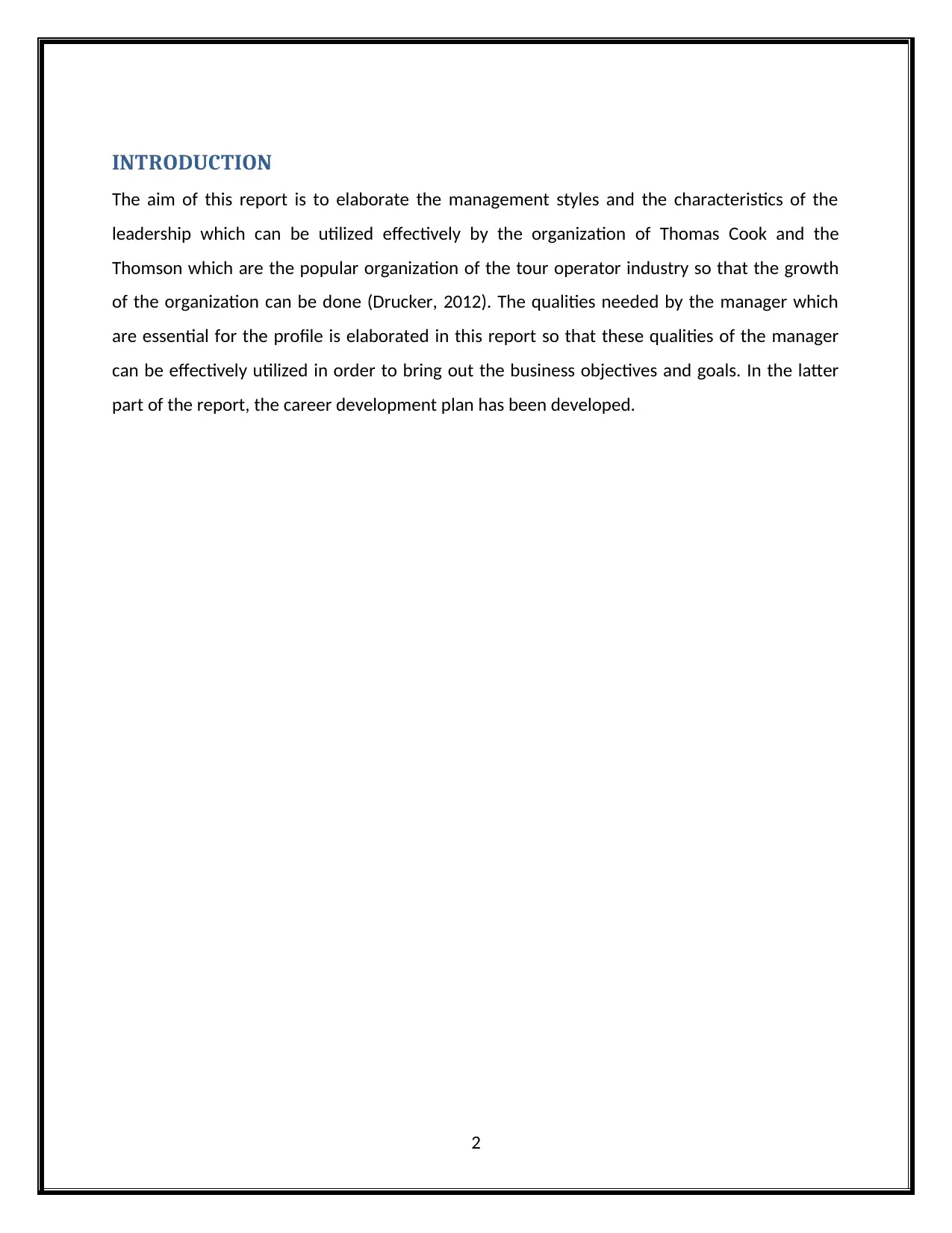
INTRODUCTION
The aim of this report is to elaborate the management styles and the characteristics of the
leadership which can be utilized effectively by the organization of Thomas Cook and the
Thomson which are the popular organization of the tour operator industry so that the growth
of the organization can be done (Drucker, 2012). The qualities needed by the manager which
are essential for the profile is elaborated in this report so that these qualities of the manager
can be effectively utilized in order to bring out the business objectives and goals. In the latter
part of the report, the career development plan has been developed.
2
The aim of this report is to elaborate the management styles and the characteristics of the
leadership which can be utilized effectively by the organization of Thomas Cook and the
Thomson which are the popular organization of the tour operator industry so that the growth
of the organization can be done (Drucker, 2012). The qualities needed by the manager which
are essential for the profile is elaborated in this report so that these qualities of the manager
can be effectively utilized in order to bring out the business objectives and goals. In the latter
part of the report, the career development plan has been developed.
2
⊘ This is a preview!⊘
Do you want full access?
Subscribe today to unlock all pages.

Trusted by 1+ million students worldwide
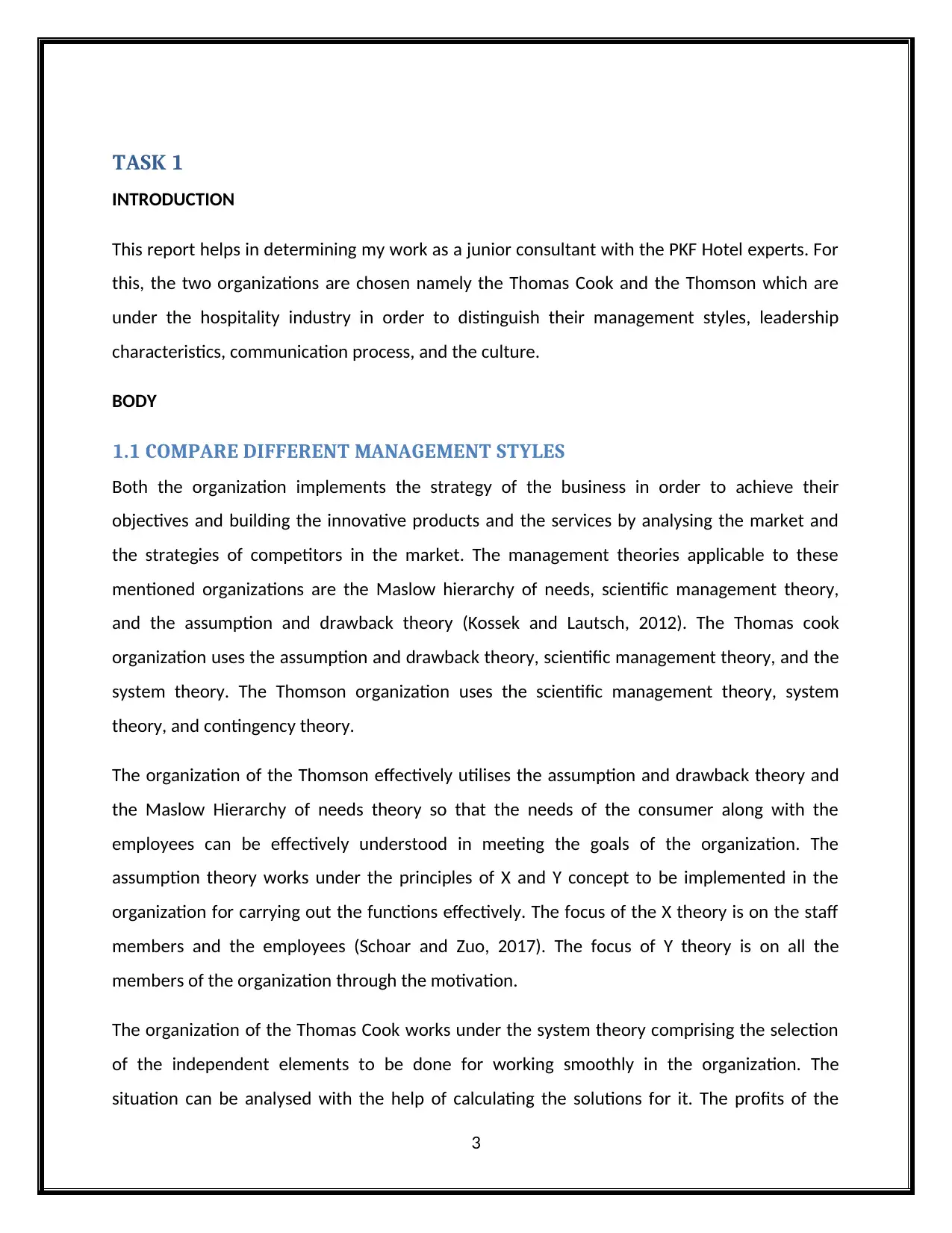
TASK 1
INTRODUCTION
This report helps in determining my work as a junior consultant with the PKF Hotel experts. For
this, the two organizations are chosen namely the Thomas Cook and the Thomson which are
under the hospitality industry in order to distinguish their management styles, leadership
characteristics, communication process, and the culture.
BODY
1.1 COMPARE DIFFERENT MANAGEMENT STYLES
Both the organization implements the strategy of the business in order to achieve their
objectives and building the innovative products and the services by analysing the market and
the strategies of competitors in the market. The management theories applicable to these
mentioned organizations are the Maslow hierarchy of needs, scientific management theory,
and the assumption and drawback theory (Kossek and Lautsch, 2012). The Thomas cook
organization uses the assumption and drawback theory, scientific management theory, and the
system theory. The Thomson organization uses the scientific management theory, system
theory, and contingency theory.
The organization of the Thomson effectively utilises the assumption and drawback theory and
the Maslow Hierarchy of needs theory so that the needs of the consumer along with the
employees can be effectively understood in meeting the goals of the organization. The
assumption theory works under the principles of X and Y concept to be implemented in the
organization for carrying out the functions effectively. The focus of the X theory is on the staff
members and the employees (Schoar and Zuo, 2017). The focus of Y theory is on all the
members of the organization through the motivation.
The organization of the Thomas Cook works under the system theory comprising the selection
of the independent elements to be done for working smoothly in the organization. The
situation can be analysed with the help of calculating the solutions for it. The profits of the
3
INTRODUCTION
This report helps in determining my work as a junior consultant with the PKF Hotel experts. For
this, the two organizations are chosen namely the Thomas Cook and the Thomson which are
under the hospitality industry in order to distinguish their management styles, leadership
characteristics, communication process, and the culture.
BODY
1.1 COMPARE DIFFERENT MANAGEMENT STYLES
Both the organization implements the strategy of the business in order to achieve their
objectives and building the innovative products and the services by analysing the market and
the strategies of competitors in the market. The management theories applicable to these
mentioned organizations are the Maslow hierarchy of needs, scientific management theory,
and the assumption and drawback theory (Kossek and Lautsch, 2012). The Thomas cook
organization uses the assumption and drawback theory, scientific management theory, and the
system theory. The Thomson organization uses the scientific management theory, system
theory, and contingency theory.
The organization of the Thomson effectively utilises the assumption and drawback theory and
the Maslow Hierarchy of needs theory so that the needs of the consumer along with the
employees can be effectively understood in meeting the goals of the organization. The
assumption theory works under the principles of X and Y concept to be implemented in the
organization for carrying out the functions effectively. The focus of the X theory is on the staff
members and the employees (Schoar and Zuo, 2017). The focus of Y theory is on all the
members of the organization through the motivation.
The organization of the Thomas Cook works under the system theory comprising the selection
of the independent elements to be done for working smoothly in the organization. The
situation can be analysed with the help of calculating the solutions for it. The profits of the
3
Paraphrase This Document
Need a fresh take? Get an instant paraphrase of this document with our AI Paraphraser
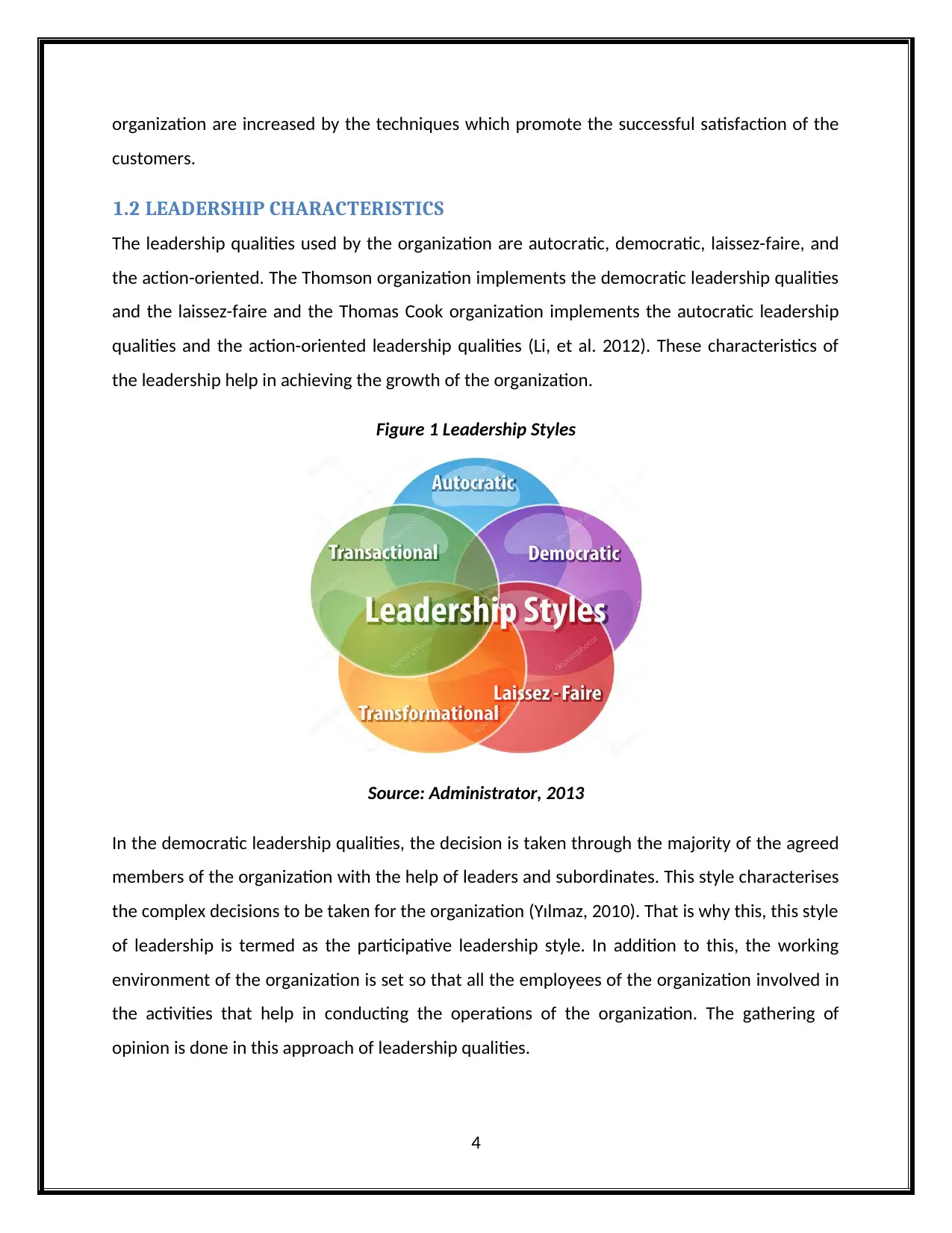
organization are increased by the techniques which promote the successful satisfaction of the
customers.
1.2 LEADERSHIP CHARACTERISTICS
The leadership qualities used by the organization are autocratic, democratic, laissez-faire, and
the action-oriented. The Thomson organization implements the democratic leadership qualities
and the laissez-faire and the Thomas Cook organization implements the autocratic leadership
qualities and the action-oriented leadership qualities (Li, et al. 2012). These characteristics of
the leadership help in achieving the growth of the organization.
Figure 1 Leadership Styles
Source: Administrator, 2013
In the democratic leadership qualities, the decision is taken through the majority of the agreed
members of the organization with the help of leaders and subordinates. This style characterises
the complex decisions to be taken for the organization (Yılmaz, 2010). That is why this, this style
of leadership is termed as the participative leadership style. In addition to this, the working
environment of the organization is set so that all the employees of the organization involved in
the activities that help in conducting the operations of the organization. The gathering of
opinion is done in this approach of leadership qualities.
4
customers.
1.2 LEADERSHIP CHARACTERISTICS
The leadership qualities used by the organization are autocratic, democratic, laissez-faire, and
the action-oriented. The Thomson organization implements the democratic leadership qualities
and the laissez-faire and the Thomas Cook organization implements the autocratic leadership
qualities and the action-oriented leadership qualities (Li, et al. 2012). These characteristics of
the leadership help in achieving the growth of the organization.
Figure 1 Leadership Styles
Source: Administrator, 2013
In the democratic leadership qualities, the decision is taken through the majority of the agreed
members of the organization with the help of leaders and subordinates. This style characterises
the complex decisions to be taken for the organization (Yılmaz, 2010). That is why this, this style
of leadership is termed as the participative leadership style. In addition to this, the working
environment of the organization is set so that all the employees of the organization involved in
the activities that help in conducting the operations of the organization. The gathering of
opinion is done in this approach of leadership qualities.
4
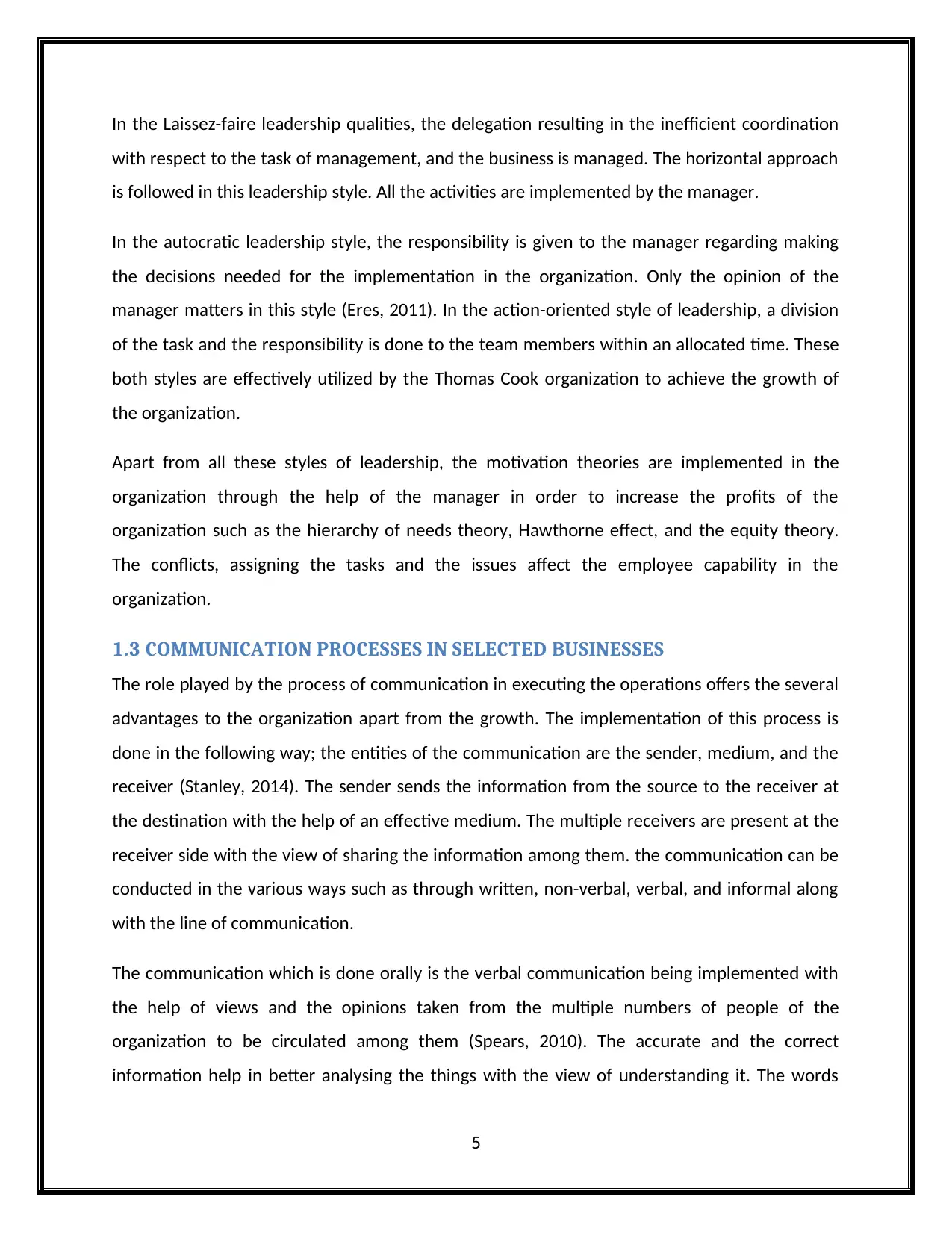
In the Laissez-faire leadership qualities, the delegation resulting in the inefficient coordination
with respect to the task of management, and the business is managed. The horizontal approach
is followed in this leadership style. All the activities are implemented by the manager.
In the autocratic leadership style, the responsibility is given to the manager regarding making
the decisions needed for the implementation in the organization. Only the opinion of the
manager matters in this style (Eres, 2011). In the action-oriented style of leadership, a division
of the task and the responsibility is done to the team members within an allocated time. These
both styles are effectively utilized by the Thomas Cook organization to achieve the growth of
the organization.
Apart from all these styles of leadership, the motivation theories are implemented in the
organization through the help of the manager in order to increase the profits of the
organization such as the hierarchy of needs theory, Hawthorne effect, and the equity theory.
The conflicts, assigning the tasks and the issues affect the employee capability in the
organization.
1.3 COMMUNICATION PROCESSES IN SELECTED BUSINESSES
The role played by the process of communication in executing the operations offers the several
advantages to the organization apart from the growth. The implementation of this process is
done in the following way; the entities of the communication are the sender, medium, and the
receiver (Stanley, 2014). The sender sends the information from the source to the receiver at
the destination with the help of an effective medium. The multiple receivers are present at the
receiver side with the view of sharing the information among them. the communication can be
conducted in the various ways such as through written, non-verbal, verbal, and informal along
with the line of communication.
The communication which is done orally is the verbal communication being implemented with
the help of views and the opinions taken from the multiple numbers of people of the
organization to be circulated among them (Spears, 2010). The accurate and the correct
information help in better analysing the things with the view of understanding it. The words
5
with respect to the task of management, and the business is managed. The horizontal approach
is followed in this leadership style. All the activities are implemented by the manager.
In the autocratic leadership style, the responsibility is given to the manager regarding making
the decisions needed for the implementation in the organization. Only the opinion of the
manager matters in this style (Eres, 2011). In the action-oriented style of leadership, a division
of the task and the responsibility is done to the team members within an allocated time. These
both styles are effectively utilized by the Thomas Cook organization to achieve the growth of
the organization.
Apart from all these styles of leadership, the motivation theories are implemented in the
organization through the help of the manager in order to increase the profits of the
organization such as the hierarchy of needs theory, Hawthorne effect, and the equity theory.
The conflicts, assigning the tasks and the issues affect the employee capability in the
organization.
1.3 COMMUNICATION PROCESSES IN SELECTED BUSINESSES
The role played by the process of communication in executing the operations offers the several
advantages to the organization apart from the growth. The implementation of this process is
done in the following way; the entities of the communication are the sender, medium, and the
receiver (Stanley, 2014). The sender sends the information from the source to the receiver at
the destination with the help of an effective medium. The multiple receivers are present at the
receiver side with the view of sharing the information among them. the communication can be
conducted in the various ways such as through written, non-verbal, verbal, and informal along
with the line of communication.
The communication which is done orally is the verbal communication being implemented with
the help of views and the opinions taken from the multiple numbers of people of the
organization to be circulated among them (Spears, 2010). The accurate and the correct
information help in better analysing the things with the view of understanding it. The words
5
⊘ This is a preview!⊘
Do you want full access?
Subscribe today to unlock all pages.

Trusted by 1+ million students worldwide
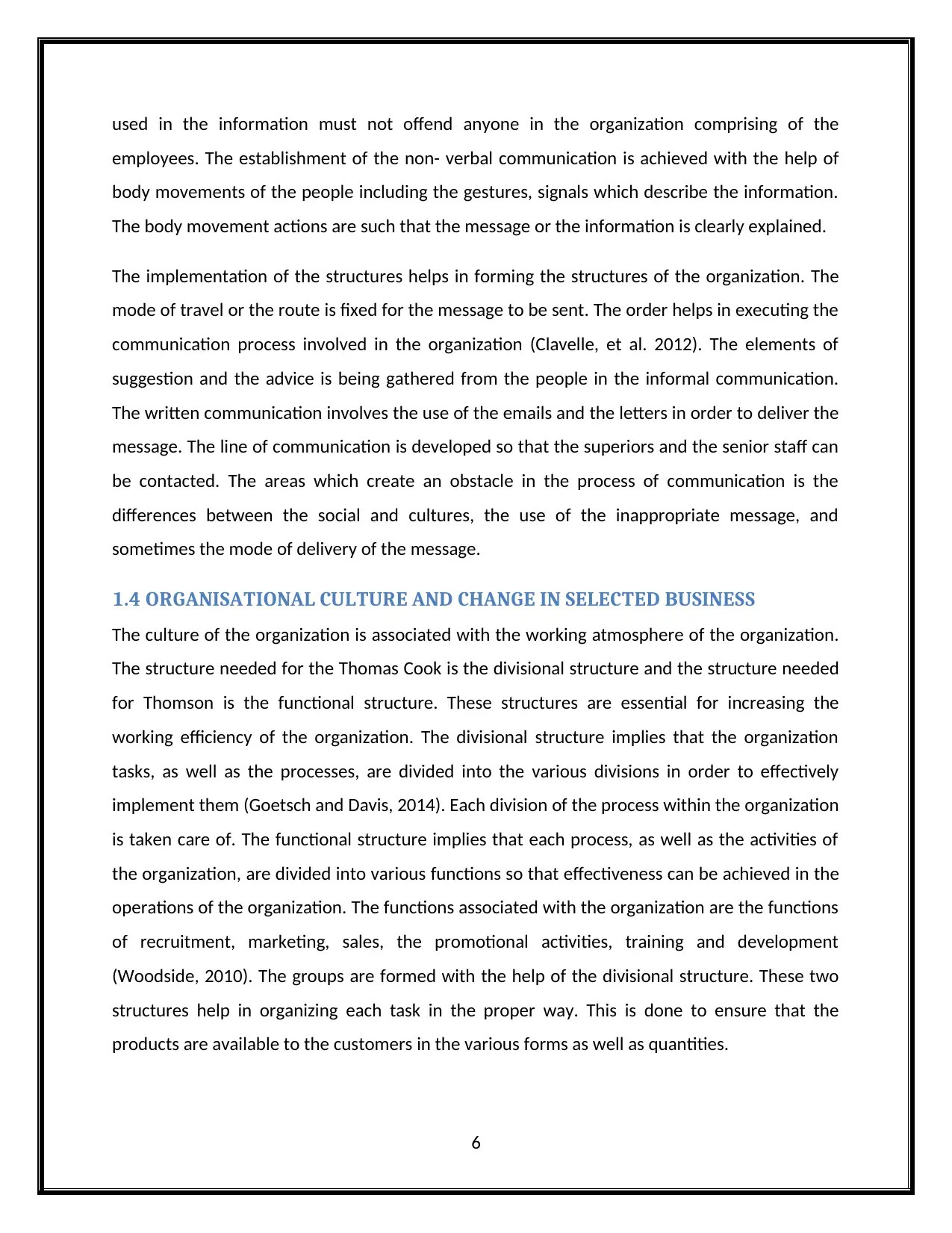
used in the information must not offend anyone in the organization comprising of the
employees. The establishment of the non- verbal communication is achieved with the help of
body movements of the people including the gestures, signals which describe the information.
The body movement actions are such that the message or the information is clearly explained.
The implementation of the structures helps in forming the structures of the organization. The
mode of travel or the route is fixed for the message to be sent. The order helps in executing the
communication process involved in the organization (Clavelle, et al. 2012). The elements of
suggestion and the advice is being gathered from the people in the informal communication.
The written communication involves the use of the emails and the letters in order to deliver the
message. The line of communication is developed so that the superiors and the senior staff can
be contacted. The areas which create an obstacle in the process of communication is the
differences between the social and cultures, the use of the inappropriate message, and
sometimes the mode of delivery of the message.
1.4 ORGANISATIONAL CULTURE AND CHANGE IN SELECTED BUSINESS
The culture of the organization is associated with the working atmosphere of the organization.
The structure needed for the Thomas Cook is the divisional structure and the structure needed
for Thomson is the functional structure. These structures are essential for increasing the
working efficiency of the organization. The divisional structure implies that the organization
tasks, as well as the processes, are divided into the various divisions in order to effectively
implement them (Goetsch and Davis, 2014). Each division of the process within the organization
is taken care of. The functional structure implies that each process, as well as the activities of
the organization, are divided into various functions so that effectiveness can be achieved in the
operations of the organization. The functions associated with the organization are the functions
of recruitment, marketing, sales, the promotional activities, training and development
(Woodside, 2010). The groups are formed with the help of the divisional structure. These two
structures help in organizing each task in the proper way. This is done to ensure that the
products are available to the customers in the various forms as well as quantities.
6
employees. The establishment of the non- verbal communication is achieved with the help of
body movements of the people including the gestures, signals which describe the information.
The body movement actions are such that the message or the information is clearly explained.
The implementation of the structures helps in forming the structures of the organization. The
mode of travel or the route is fixed for the message to be sent. The order helps in executing the
communication process involved in the organization (Clavelle, et al. 2012). The elements of
suggestion and the advice is being gathered from the people in the informal communication.
The written communication involves the use of the emails and the letters in order to deliver the
message. The line of communication is developed so that the superiors and the senior staff can
be contacted. The areas which create an obstacle in the process of communication is the
differences between the social and cultures, the use of the inappropriate message, and
sometimes the mode of delivery of the message.
1.4 ORGANISATIONAL CULTURE AND CHANGE IN SELECTED BUSINESS
The culture of the organization is associated with the working atmosphere of the organization.
The structure needed for the Thomas Cook is the divisional structure and the structure needed
for Thomson is the functional structure. These structures are essential for increasing the
working efficiency of the organization. The divisional structure implies that the organization
tasks, as well as the processes, are divided into the various divisions in order to effectively
implement them (Goetsch and Davis, 2014). Each division of the process within the organization
is taken care of. The functional structure implies that each process, as well as the activities of
the organization, are divided into various functions so that effectiveness can be achieved in the
operations of the organization. The functions associated with the organization are the functions
of recruitment, marketing, sales, the promotional activities, training and development
(Woodside, 2010). The groups are formed with the help of the divisional structure. These two
structures help in organizing each task in the proper way. This is done to ensure that the
products are available to the customers in the various forms as well as quantities.
6
Paraphrase This Document
Need a fresh take? Get an instant paraphrase of this document with our AI Paraphraser
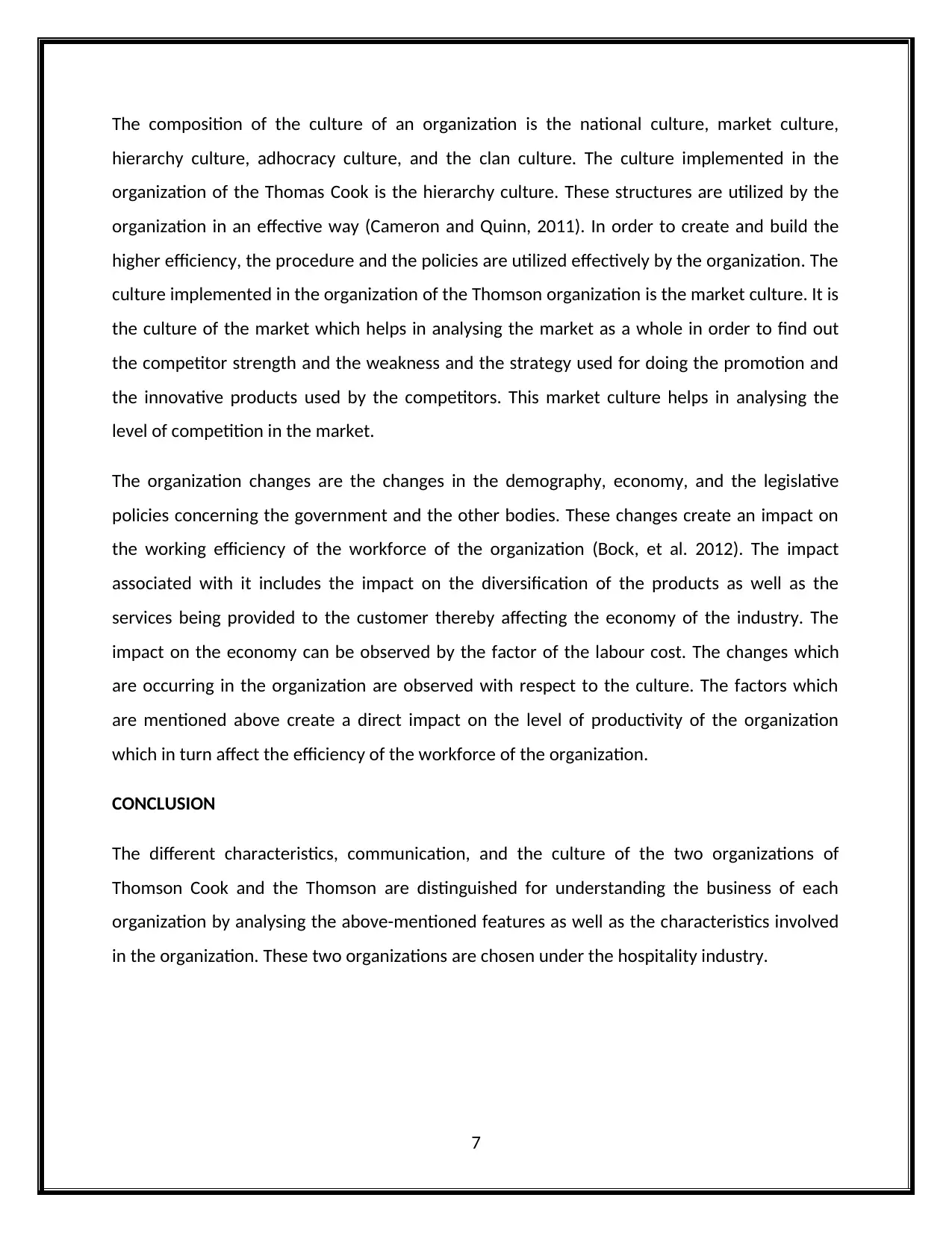
The composition of the culture of an organization is the national culture, market culture,
hierarchy culture, adhocracy culture, and the clan culture. The culture implemented in the
organization of the Thomas Cook is the hierarchy culture. These structures are utilized by the
organization in an effective way (Cameron and Quinn, 2011). In order to create and build the
higher efficiency, the procedure and the policies are utilized effectively by the organization. The
culture implemented in the organization of the Thomson organization is the market culture. It is
the culture of the market which helps in analysing the market as a whole in order to find out
the competitor strength and the weakness and the strategy used for doing the promotion and
the innovative products used by the competitors. This market culture helps in analysing the
level of competition in the market.
The organization changes are the changes in the demography, economy, and the legislative
policies concerning the government and the other bodies. These changes create an impact on
the working efficiency of the workforce of the organization (Bock, et al. 2012). The impact
associated with it includes the impact on the diversification of the products as well as the
services being provided to the customer thereby affecting the economy of the industry. The
impact on the economy can be observed by the factor of the labour cost. The changes which
are occurring in the organization are observed with respect to the culture. The factors which
are mentioned above create a direct impact on the level of productivity of the organization
which in turn affect the efficiency of the workforce of the organization.
CONCLUSION
The different characteristics, communication, and the culture of the two organizations of
Thomson Cook and the Thomson are distinguished for understanding the business of each
organization by analysing the above-mentioned features as well as the characteristics involved
in the organization. These two organizations are chosen under the hospitality industry.
7
hierarchy culture, adhocracy culture, and the clan culture. The culture implemented in the
organization of the Thomas Cook is the hierarchy culture. These structures are utilized by the
organization in an effective way (Cameron and Quinn, 2011). In order to create and build the
higher efficiency, the procedure and the policies are utilized effectively by the organization. The
culture implemented in the organization of the Thomson organization is the market culture. It is
the culture of the market which helps in analysing the market as a whole in order to find out
the competitor strength and the weakness and the strategy used for doing the promotion and
the innovative products used by the competitors. This market culture helps in analysing the
level of competition in the market.
The organization changes are the changes in the demography, economy, and the legislative
policies concerning the government and the other bodies. These changes create an impact on
the working efficiency of the workforce of the organization (Bock, et al. 2012). The impact
associated with it includes the impact on the diversification of the products as well as the
services being provided to the customer thereby affecting the economy of the industry. The
impact on the economy can be observed by the factor of the labour cost. The changes which
are occurring in the organization are observed with respect to the culture. The factors which
are mentioned above create a direct impact on the level of productivity of the organization
which in turn affect the efficiency of the workforce of the organization.
CONCLUSION
The different characteristics, communication, and the culture of the two organizations of
Thomson Cook and the Thomson are distinguished for understanding the business of each
organization by analysing the above-mentioned features as well as the characteristics involved
in the organization. These two organizations are chosen under the hospitality industry.
7
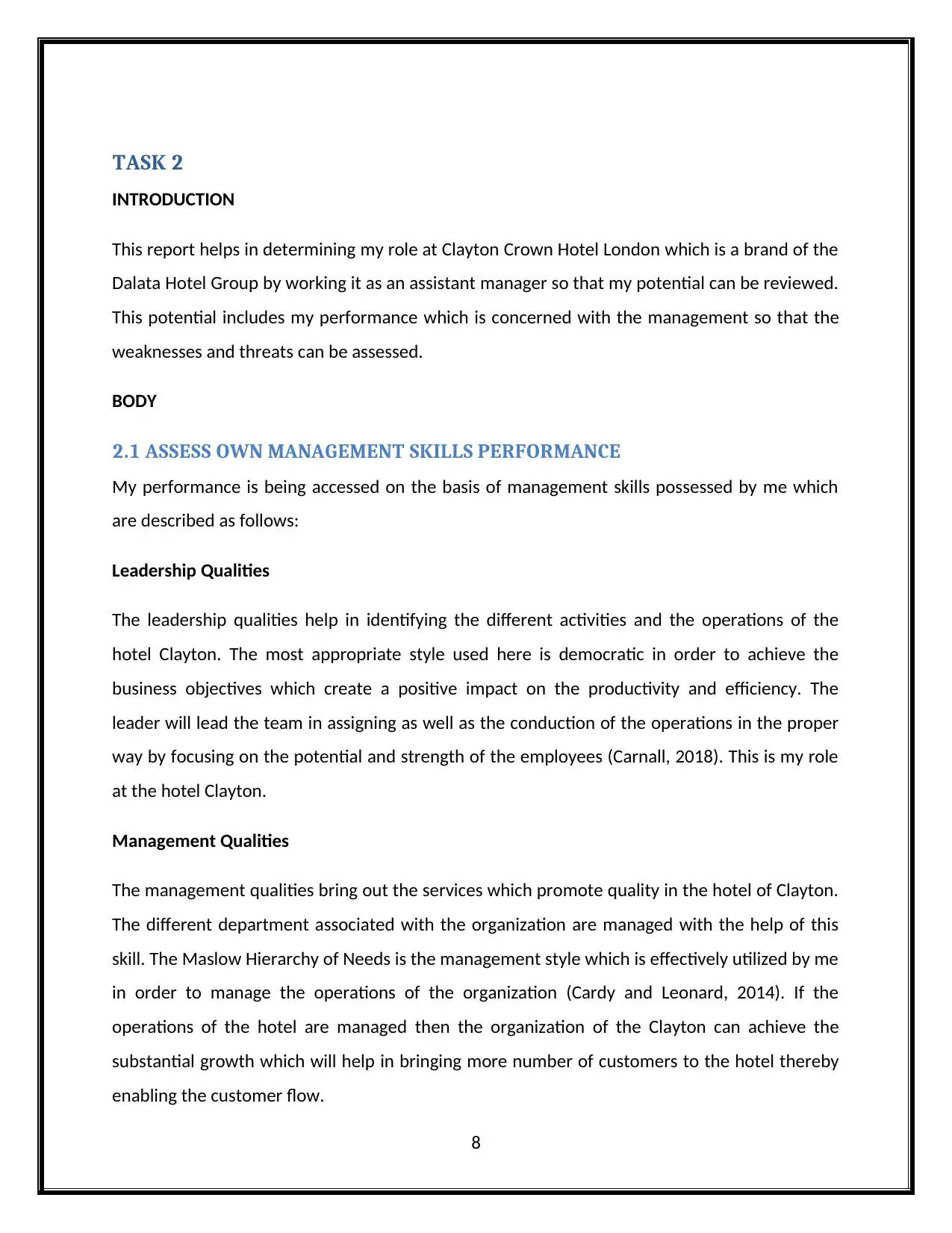
TASK 2
INTRODUCTION
This report helps in determining my role at Clayton Crown Hotel London which is a brand of the
Dalata Hotel Group by working it as an assistant manager so that my potential can be reviewed.
This potential includes my performance which is concerned with the management so that the
weaknesses and threats can be assessed.
BODY
2.1 ASSESS OWN MANAGEMENT SKILLS PERFORMANCE
My performance is being accessed on the basis of management skills possessed by me which
are described as follows:
Leadership Qualities
The leadership qualities help in identifying the different activities and the operations of the
hotel Clayton. The most appropriate style used here is democratic in order to achieve the
business objectives which create a positive impact on the productivity and efficiency. The
leader will lead the team in assigning as well as the conduction of the operations in the proper
way by focusing on the potential and strength of the employees (Carnall, 2018). This is my role
at the hotel Clayton.
Management Qualities
The management qualities bring out the services which promote quality in the hotel of Clayton.
The different department associated with the organization are managed with the help of this
skill. The Maslow Hierarchy of Needs is the management style which is effectively utilized by me
in order to manage the operations of the organization (Cardy and Leonard, 2014). If the
operations of the hotel are managed then the organization of the Clayton can achieve the
substantial growth which will help in bringing more number of customers to the hotel thereby
enabling the customer flow.
8
INTRODUCTION
This report helps in determining my role at Clayton Crown Hotel London which is a brand of the
Dalata Hotel Group by working it as an assistant manager so that my potential can be reviewed.
This potential includes my performance which is concerned with the management so that the
weaknesses and threats can be assessed.
BODY
2.1 ASSESS OWN MANAGEMENT SKILLS PERFORMANCE
My performance is being accessed on the basis of management skills possessed by me which
are described as follows:
Leadership Qualities
The leadership qualities help in identifying the different activities and the operations of the
hotel Clayton. The most appropriate style used here is democratic in order to achieve the
business objectives which create a positive impact on the productivity and efficiency. The
leader will lead the team in assigning as well as the conduction of the operations in the proper
way by focusing on the potential and strength of the employees (Carnall, 2018). This is my role
at the hotel Clayton.
Management Qualities
The management qualities bring out the services which promote quality in the hotel of Clayton.
The different department associated with the organization are managed with the help of this
skill. The Maslow Hierarchy of Needs is the management style which is effectively utilized by me
in order to manage the operations of the organization (Cardy and Leonard, 2014). If the
operations of the hotel are managed then the organization of the Clayton can achieve the
substantial growth which will help in bringing more number of customers to the hotel thereby
enabling the customer flow.
8
⊘ This is a preview!⊘
Do you want full access?
Subscribe today to unlock all pages.

Trusted by 1+ million students worldwide

Technical Abilities
The technical abilities for becoming the assistant manager are such that the degree from the
recognized university. The graduation and the post- graduation is the degree needed. In
addition to this, the person must have the practical implementation which is the desired
characteristics preferred by the organization (Drucker, 2012). The technical abilities help in
solving the technical issues encountered within the organization. Knowledge of the technology
is must for solving such issues.
Personal Qualities
My personal skills are the communication and the interpersonal skills. The composition of the
interpersonal skills is the verbal and non- verbal communication, handling the situations
through negotiation, decision-making process, etc. The skills of motivating and encouraging
others are also possessed by me (Succar, et al. 2012). These personal qualities help in acquiring
the goal set for the organization.
Organizing and Planning Abilities
The abilities included in this skill is composed of the skills of analysis, evaluation, problem
solver, the ability to deceive others which helps in effective planning and organizing the things.
These abilities act as a support in meeting the objectives of the hotel (Aguinis, 2013). The
planning approach helps in an arrangement of the organizing the activities and operations in
the proper manner.
2.2 ANALYSE PERSONAL STRENGTHS, WEAKNESSES, OPPORTUNITIES AND
THREATS
Figure 2 SWOT Analysis
9
The technical abilities for becoming the assistant manager are such that the degree from the
recognized university. The graduation and the post- graduation is the degree needed. In
addition to this, the person must have the practical implementation which is the desired
characteristics preferred by the organization (Drucker, 2012). The technical abilities help in
solving the technical issues encountered within the organization. Knowledge of the technology
is must for solving such issues.
Personal Qualities
My personal skills are the communication and the interpersonal skills. The composition of the
interpersonal skills is the verbal and non- verbal communication, handling the situations
through negotiation, decision-making process, etc. The skills of motivating and encouraging
others are also possessed by me (Succar, et al. 2012). These personal qualities help in acquiring
the goal set for the organization.
Organizing and Planning Abilities
The abilities included in this skill is composed of the skills of analysis, evaluation, problem
solver, the ability to deceive others which helps in effective planning and organizing the things.
These abilities act as a support in meeting the objectives of the hotel (Aguinis, 2013). The
planning approach helps in an arrangement of the organizing the activities and operations in
the proper manner.
2.2 ANALYSE PERSONAL STRENGTHS, WEAKNESSES, OPPORTUNITIES AND
THREATS
Figure 2 SWOT Analysis
9
Paraphrase This Document
Need a fresh take? Get an instant paraphrase of this document with our AI Paraphraser
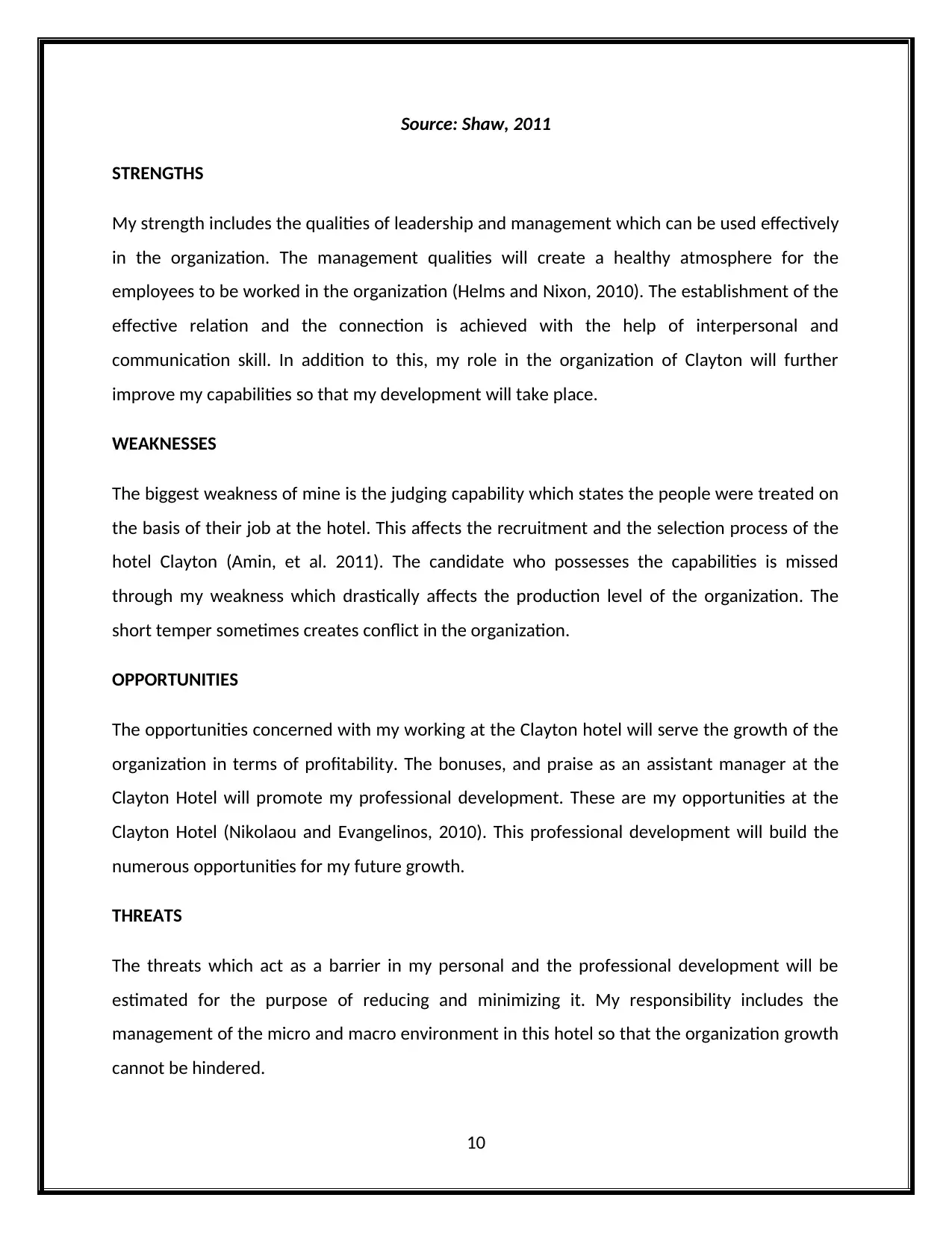
Source: Shaw, 2011
STRENGTHS
My strength includes the qualities of leadership and management which can be used effectively
in the organization. The management qualities will create a healthy atmosphere for the
employees to be worked in the organization (Helms and Nixon, 2010). The establishment of the
effective relation and the connection is achieved with the help of interpersonal and
communication skill. In addition to this, my role in the organization of Clayton will further
improve my capabilities so that my development will take place.
WEAKNESSES
The biggest weakness of mine is the judging capability which states the people were treated on
the basis of their job at the hotel. This affects the recruitment and the selection process of the
hotel Clayton (Amin, et al. 2011). The candidate who possesses the capabilities is missed
through my weakness which drastically affects the production level of the organization. The
short temper sometimes creates conflict in the organization.
OPPORTUNITIES
The opportunities concerned with my working at the Clayton hotel will serve the growth of the
organization in terms of profitability. The bonuses, and praise as an assistant manager at the
Clayton Hotel will promote my professional development. These are my opportunities at the
Clayton Hotel (Nikolaou and Evangelinos, 2010). This professional development will build the
numerous opportunities for my future growth.
THREATS
The threats which act as a barrier in my personal and the professional development will be
estimated for the purpose of reducing and minimizing it. My responsibility includes the
management of the micro and macro environment in this hotel so that the organization growth
cannot be hindered.
10
STRENGTHS
My strength includes the qualities of leadership and management which can be used effectively
in the organization. The management qualities will create a healthy atmosphere for the
employees to be worked in the organization (Helms and Nixon, 2010). The establishment of the
effective relation and the connection is achieved with the help of interpersonal and
communication skill. In addition to this, my role in the organization of Clayton will further
improve my capabilities so that my development will take place.
WEAKNESSES
The biggest weakness of mine is the judging capability which states the people were treated on
the basis of their job at the hotel. This affects the recruitment and the selection process of the
hotel Clayton (Amin, et al. 2011). The candidate who possesses the capabilities is missed
through my weakness which drastically affects the production level of the organization. The
short temper sometimes creates conflict in the organization.
OPPORTUNITIES
The opportunities concerned with my working at the Clayton hotel will serve the growth of the
organization in terms of profitability. The bonuses, and praise as an assistant manager at the
Clayton Hotel will promote my professional development. These are my opportunities at the
Clayton Hotel (Nikolaou and Evangelinos, 2010). This professional development will build the
numerous opportunities for my future growth.
THREATS
The threats which act as a barrier in my personal and the professional development will be
estimated for the purpose of reducing and minimizing it. My responsibility includes the
management of the micro and macro environment in this hotel so that the organization growth
cannot be hindered.
10

In order to calculate the threats and the weaknesses associated with my working, a personal log
will be designed for the identification of the above-mentioned factors (Ommani, 2011). Apart
from these, the processes will be included in the plan of development so that these factors can
be handled in an efficient way.
2.3 SET AND PRIORITISE OBJECTIVES AND TARGETS TO DEVELOP OWN
POTENTIAL
The set of targets and the objectives are being assigned to me in order to complete the task on
time thereby enhancing the potential. The composition of the target includes the activities
necessary in the hotel organization which needed to be done with the efficient use of the
qualities. The advantage of this target will cover my development as a whole. In order to add
the extra advantage, the SMART objectives are defined in order to understand the threatening
areas by analysing and measuring it (Waage, et al. 2010). The purpose of setting the SMART
objectives is to complete the task on time needed by it. The practical implementation of this
approach is followed for achieving the SMART objectives.
The qualities of management and the capabilities of the behaviour will get utilized in the
organization very well. My area of improvement is the interpersonal skills which need certain
modifications after improving it. The other areas of concern of doing the modification in the
lists are the analytical and decision-making abilities (Morisano and Shore, 2010). The short
temper behaviour of mine is also to be worked through the assistance which helps in managing
the anger with the view of control management.
The development of the action plan will include the modification needed in order to modify the
certain areas on which the improvement need arises. The estimation of the threats affecting my
performance would be analysed so that performance management can be done. These areas
will promote the future growth by enhancing the positions.
CONCLUSION
11
will be designed for the identification of the above-mentioned factors (Ommani, 2011). Apart
from these, the processes will be included in the plan of development so that these factors can
be handled in an efficient way.
2.3 SET AND PRIORITISE OBJECTIVES AND TARGETS TO DEVELOP OWN
POTENTIAL
The set of targets and the objectives are being assigned to me in order to complete the task on
time thereby enhancing the potential. The composition of the target includes the activities
necessary in the hotel organization which needed to be done with the efficient use of the
qualities. The advantage of this target will cover my development as a whole. In order to add
the extra advantage, the SMART objectives are defined in order to understand the threatening
areas by analysing and measuring it (Waage, et al. 2010). The purpose of setting the SMART
objectives is to complete the task on time needed by it. The practical implementation of this
approach is followed for achieving the SMART objectives.
The qualities of management and the capabilities of the behaviour will get utilized in the
organization very well. My area of improvement is the interpersonal skills which need certain
modifications after improving it. The other areas of concern of doing the modification in the
lists are the analytical and decision-making abilities (Morisano and Shore, 2010). The short
temper behaviour of mine is also to be worked through the assistance which helps in managing
the anger with the view of control management.
The development of the action plan will include the modification needed in order to modify the
certain areas on which the improvement need arises. The estimation of the threats affecting my
performance would be analysed so that performance management can be done. These areas
will promote the future growth by enhancing the positions.
CONCLUSION
11
⊘ This is a preview!⊘
Do you want full access?
Subscribe today to unlock all pages.

Trusted by 1+ million students worldwide
1 out of 24
Related Documents
Your All-in-One AI-Powered Toolkit for Academic Success.
+13062052269
info@desklib.com
Available 24*7 on WhatsApp / Email
![[object Object]](/_next/static/media/star-bottom.7253800d.svg)
Unlock your academic potential
Copyright © 2020–2025 A2Z Services. All Rights Reserved. Developed and managed by ZUCOL.



